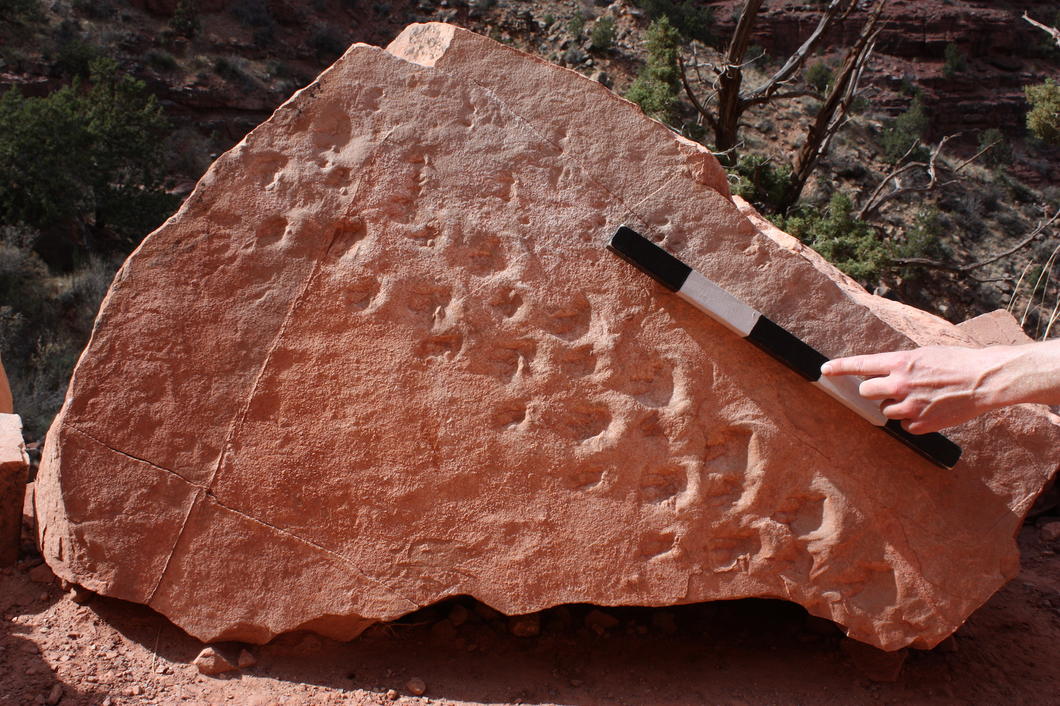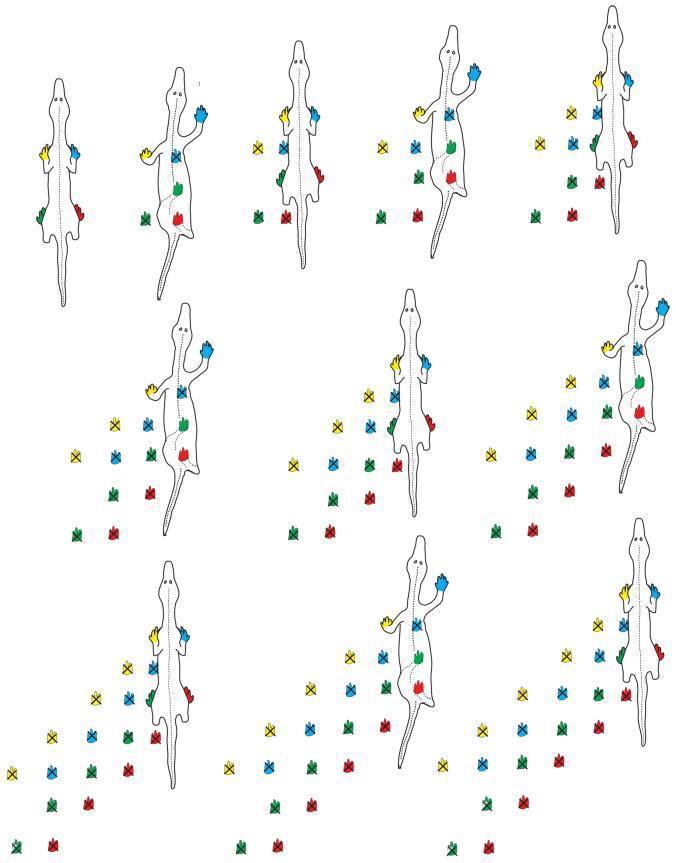Oldest known footprints in Grand Canyon were left by mysterious, sideways-walking reptile
The ancient vertebrate left a sideways-drifting trackway.

Editor's Note: This story was updated on Aug. 24, 2020 date to include the journal where the research, which was initially presented at the Society of Vertebrate Paleontology annual meeting in 2018, was eventually published.
About 315 million years ago — long before dinosaurs roamed the Earth — an early reptile scuttled along in a strangely sideways jaunt, leaving its tiny footprints embedded in the landscape, new research finds.
It's anyone's guess why this ancient, clawed critter walked sideways (although experts have several ideas), but one thing is certain: The animal's prints represent the oldest-known vertebrate track marks ever discovered in Grand Canyon National Park, said Stephen Rowland, a professor of geology at the University of Nevada, Las Vegas, who is studying the fossilized trackway.
The trackway is so old, that it was made a mere 5 million years after the first known reptiles emerged on Earth, just as the ancient supercontinent Pangaea was forming. "This is right in that little window of the very first reptiles," Rowland told Live Science. "We don't know much about that real early history."
Related: Photos: Dinosaur tracks reveal Australia's 'Jurassic Park'
The research, which has yet to be published in a peer-reviewed journal, was presented at the annual Society of Vertebrate Paleontology meeting in Albuquerque, New Mexico, on Oct. 17. (Editor's note: Research on these footprints has now been published online on Aug. 19 in the journal PLOS One.)
The trackway — preserved on a slab of sandstone measuring about 3.2 feet long and 18 inches wide (1 meter by 45 centimeters) — contains 28 prints from the mystery animal's front and back feet. A friend of Rowland's first noticed the fossilized tracks in 2016 while hiking along the Grand Canyon's Bright Angel Trail, located on the Manakacha formation in northern Arizona.
Get the world’s most fascinating discoveries delivered straight to your inbox.
When Rowland visited the site in May 2017, the 2-inch-long (5 cm) prints befuddled him. At first glance, the track marks looked as if they were left by two animals walking side by side, "which is very bizarre for an early reptile," he said. After lying awake at night, turning the images over in his mind, Rowland had an epiphany: The animal that left the tracks was moving sideways.
Normally, four-legged animals walking forward obscure some of their footprints, with the rear foot stepping on top of the front footprint. "In this case, that didn't happen," Rowland said.
He noticed that while the animal's tiny claws were pointing forward, the animal was moving sideways, about 40 degrees toward to the right (each row is offset to the right by about 8 inches (20 cm) compared with the previous row, Rowland said.) Perhaps, a strong wind from the left was blowing against the creature, pushing it sideways. Or, maybe the creature was trying to climb a steep incline and was walking up the slope diagonally. It's even possible that the reptile was walking sideways because it was injured, circling an aggressor or doing a mating dance, Rowland said.
"I don't think we'll know with any confidence," Rowland said.
When the prints were made, during the Carboniferous period (about 359 million to 299 million years ago), Arizona lay close to the equator. At that time, the mysterious reptile walked over a coastal sand dune near a shallow sea to the west, according to co-researcher Mario Caputo, a retired adjunct professor of sedimentology at San Diego State University.
The next-oldest fossilized vertebrate track marks in the Grand Canyon are about 20 million years younger, from the Coconino Sandstone formation, Rowland noted. These date to the Permian period, (about 299 million to 251 million years ago). Because the different trackways look so similar, it's likely that they will be given the same scientific name of Chelichnus, Rowland said. (Like species, fossilized prints are given scientific names.)
"That doesn't mean it was the same animal living in different places," Rowland said. Rather, because the prints look so similar, they're given the same name, even if a different animal made them, he said.
Originally published on Live Science.

Laura is the managing editor at Live Science. She also runs the archaeology section and the Life's Little Mysteries series. Her work has appeared in The New York Times, Scholastic, Popular Science and Spectrum, a site on autism research. She has won multiple awards from the Society of Professional Journalists and the Washington Newspaper Publishers Association for her reporting at a weekly newspaper near Seattle. Laura holds a bachelor's degree in English literature and psychology from Washington University in St. Louis and a master's degree in science writing from NYU.



